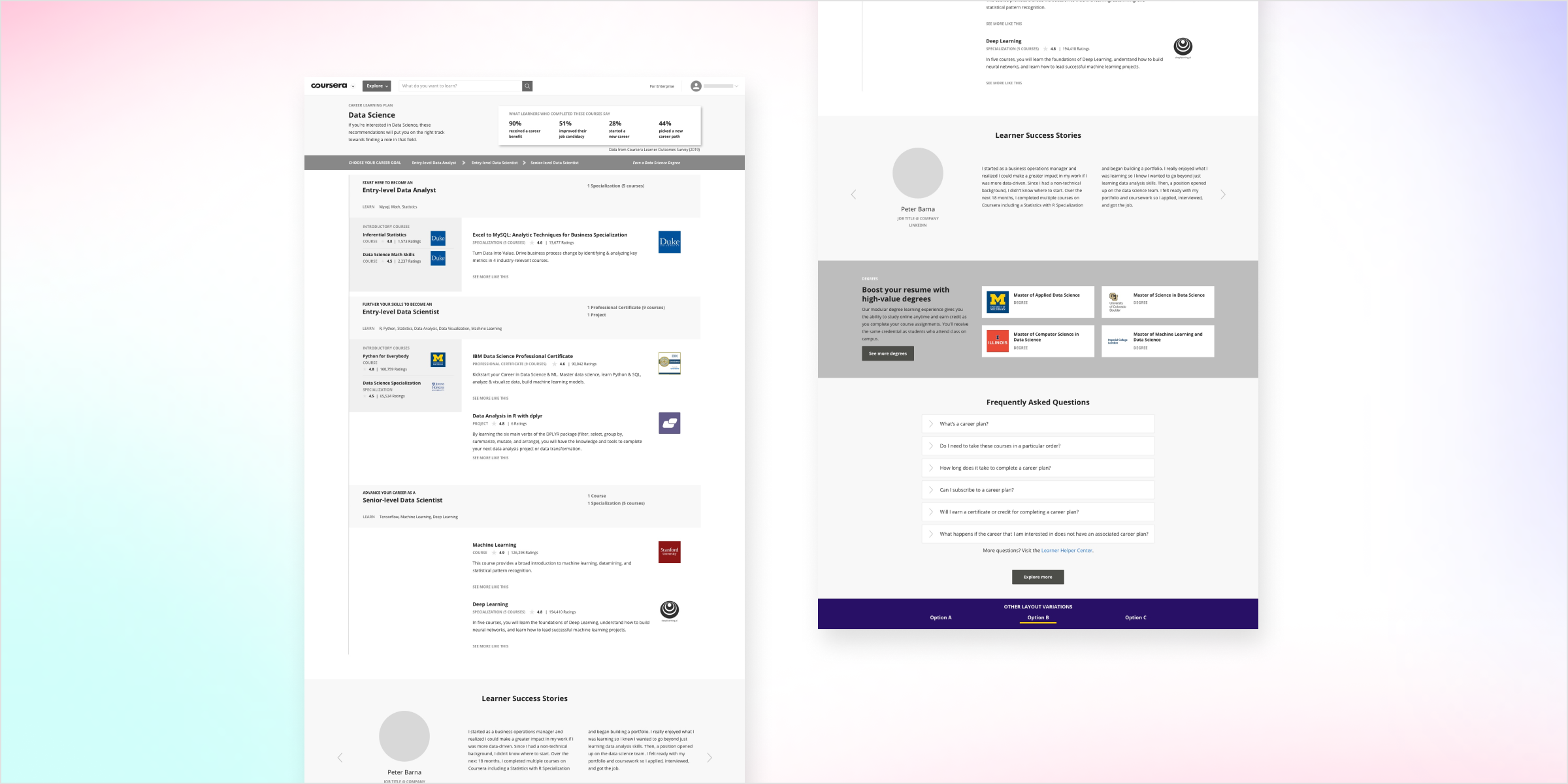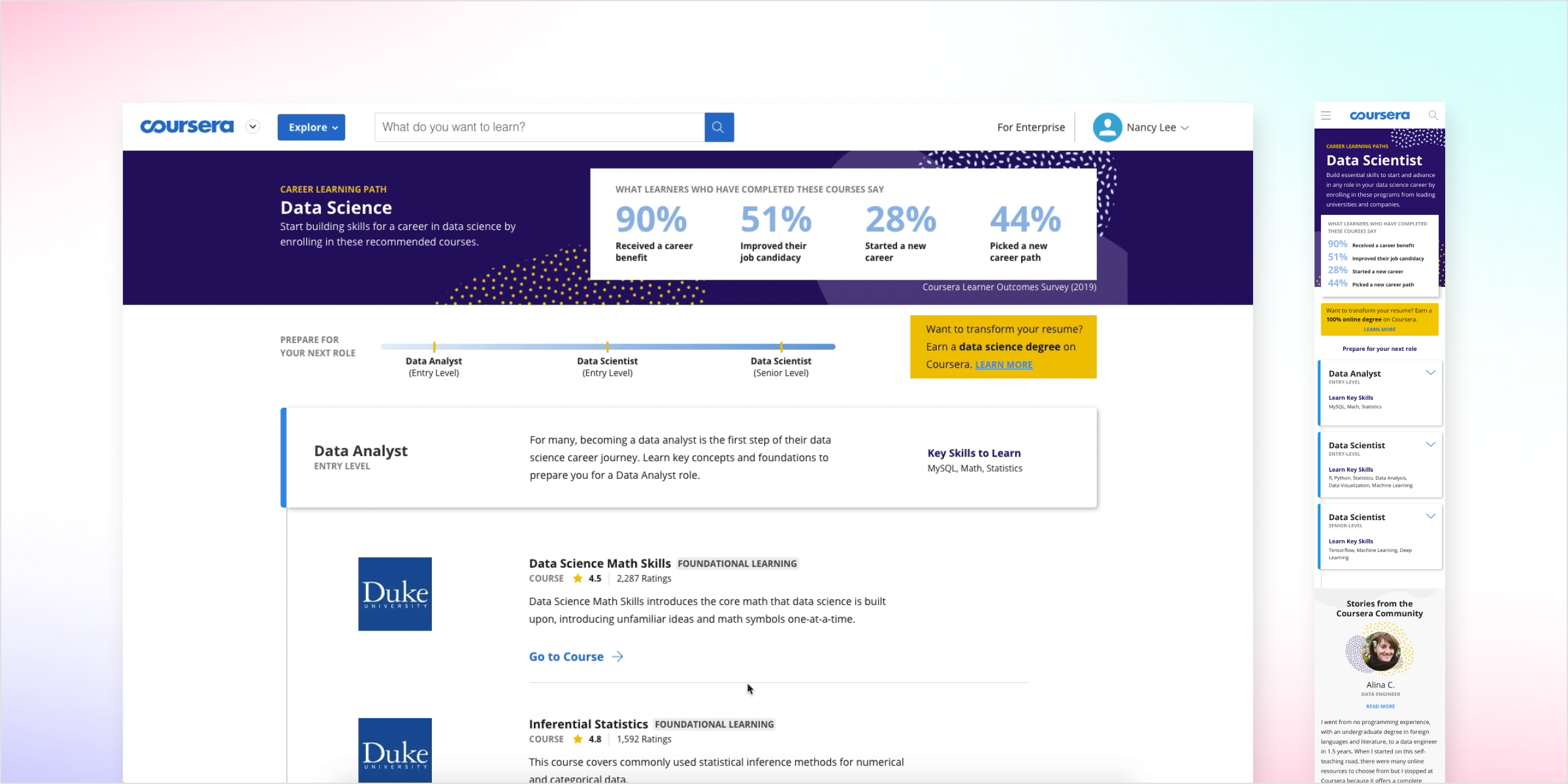Career Learning Paths
Helping learners commit and make progress by organizing Coursera content into role progressions and skills needed at each stage of their careers.
Overview
Problem Statement
Learners who are trying to switch into a new field or industry often feel too overwhelmed to start learning, and don’t know where to start. They want to learn the skills they see in job descriptions, see how learners like them have succeeded, and other signals that demonstrate job outcomes.
How might we: guide career switchers to discover our top content and believe our offerings are job-relevant and lead to real outcomes?
Audience
Early stage explorers who want to get their feet wet and/or learn a tool
Committed switchers who want guarantee of job outcome and acquire signals recognized by hiring managers
Team
Initial Core team
Product Manager
Product Designer (Me)
Product Marketing Manager
User Researcher
Content Strategy
Product Launch Team:
Product Manager
Product Designer (Me)
Product Marketing Manager
Engineering Manager + 3 engineers
Timeline
Q1 & Q2 2020
Process
Shaping: Value props and prioritized solutions
Ideation and Hypothesis Validation via PDF promotion
Low-fidelity wireframes and Usertesting.com
A/B test with Data Science MVP
Go-to-market Launch with 6 Career Learning Paths
Data Scientist, Digital Marketer, Project Manager, Network Engineer, Data Engineer, Designer
Outcome
Increased enrollment rate vs visitors who didn’t see a Learning Path
87% felt CLPs were moderately to extremely helpful
8/10 would recommend to friends
Live pages: Data Science Career Learning Path, Digital Marketing Learning Path, Design Learning Path, Data Engineering Learning Path, Network Engineering Learning Path, Agile Project Management Learning Path
Next steps:
Add on-site discoverability and promote via marketing channels. (Paused)
Expand with 10 more Learning Paths in Q4 (Paused)
After a year of experiments that yielded mostly neutral to slightly positive results, the Growth Discovery team decided we wanted to take a back to basics approach in 2020. We realized that we were building reactively and not finding impactful solutions because we were not solving the right problems. We knew learners were feeling blocked before enrolling, and this was our plan:
Step into the learner’s shoes, to learn from their experiences and identify deeply felt needs and pains.
Test the most critical assumption: come up with a hypothesis, get evidence, then confirm or pivot.
Small scale tests that were rooted in reality to track what learners would do and give us high value learnings.
Shaping: Value props and prioritized solutions
First, we needed to figure out the exact problem we were solving and get into our learners’ heads. Our lead user researcher ran a workshop to identify our learners’ motivations for their needs, pains, and gains:
These were the key problems we had to solve:
Our browse pages showed too much content
We hid the best with the rest
Learners are overwhelmed and didn’t know where to start
Learners wanted to know which content will get them career outcomes
Ideating and Validating Career Learning Paths
Through brainstorming and whiteboarding, our hypothesis to unblock learners from enrolling was a role and skill-oriented guide to help learners find content relevant to their career goals, and a clear path to advance in the field.
While we believed Career Learning Paths was the answer, we wanted to first validate the idea (quickly and inexpensively, via a painted door PDF test. As the lead designer on this project, I took our sketches from the working session and synthesized it into a downloadable, printable PDF.
We used our site-wide promotional system to attract users who were interested in starting a career in Data Science, which gave them a link to download the PDF and asked them to take a survey and participate in user interviews.
What resonated with our learners:
Grouping content by role
Skill and tool lists matched job description terms
Emphasis on brands
Emphasis on learner outcomes
Results from PDF tests
2X download rates relative to promo baseline
74% satisfied (survey, n=34)
5% enrollment rate (in the same course as the Learning path)
It’s also helpful to look at our site discovery flow, our user’s journey from then they first land on Coursera to when they start learning. One of Coursera’s value props is access to thousands of courses, but as you can see, navigating this catalog and the journey to start learning can be daunting. With a career guide, we would bypass our discovery experience, and focus a learner’s journey on the relevant content for their goals, streamlining that discovery and decision process.
This gave us enough information to move forward with productizing Career Learning Paths.
We continued exploring Career Learning Paths by creating an interactive prototype to put in front of users and get more qualitative feedback, as well as testing for usability. Our user researcher had to move on to another project, so I used UserTesting.com to run these as usability tests/user interviews. After I had created some medium-fidelity interactive prototypes, I also wrote a script to set up and sequence the user prompts in UserTesting.com. We walked through key functions and also asked questions such as:
If you were thinking about switching into Data Science, is it clear which course would be the right place to start learning?
Do you feel confident that these are the right courses to take? What outcome would you expect after finishing these courses?
Is there a sense of order to these paths? Do you feel like they all need to be taken sequentially?
What other areas of the page resonated with you?
Results from Live Prototype/Usertesting.com
What worked well
Learners could explore and compare learning programs
Clear sequence of content streamlined decision making
Titles, skills, brands conveyed job relevance
Learner outcomes from stats and community stories gave them validation
Things to improve
Information hierarchy
Learning paths resonated more with those new to the field
With these great insights, we decided it was time to start building the real deal, an interactive Career Learning Path on Coursera.org.
Building the Data Scientist Learning Path MVP
Engineering had been looped in while we were engaging in our user studies, so some of the backend engineering work had been started, and at this point, front-end development was all that was left. I had created several variations of the layout and we used the one that the majority had preferred in our user study. I applied some visual styling and layered in our intermediary brand elements (our big rebrandnd would happen later this year), and kept it fairly neutral but with some personality. I also built out our responsive layouts, as discovery and enrollment tends to happen primarily on mobile web. We launched the Data Scientist Career Learning Path in late Q2 2020.
Results from the A/B Test
The Data Scientist Career Learning Path helped learners pick a course with more confidence and ease
6/10 learners found the page very or extremely helpful
8/10 learners were likely to recommend the page to others
What learner needs were Learning Paths supporting? And what was the value we were giving learners?
“There are so many options to choose from in terms of data science courses so having them neatly ranked by difficulty and level was great”
“[Career Learning Paths] provided clear direction on how to improve as a data scientist”
With these promising results, we knew we validated our hypothesis, that role-based and skill-based guides did resonate with our learners, but it also led to exposing that our on-site navigation was not optimized for discovery, which initiated a revamping of our megamenu, product taxonomy, and information hierarchy.
Other learnings from Career Learning Paths will be used to inform the next set of iterations:
placing more emphasis on skills gained and evidence that these programs are the best options
ability to quickly access more information about the learning program, career resources, industry jargon, etc
place more emphasis on career outcomes, adding clarity on foundational courses
adding the ability to customize the plan and track progress.
Eventually, Career Learning Paths did end up being put on hold/converging with another business initiative, as leadership saw potential to monetize Learning Paths as part of another business initiative.
My takeaways
We took a very high-level approach to a problem by going back to basics, starting from a value prop workshop to ask what we were solving for our users, and we were able to gain meaningful learnings that did show very promising results in how we would shape Growth Discovery at Coursera.
I was able to work closely and collaboratively with content strategy and user research (I even had to run a user study!), so it definitely gave me opportunity to flex those muscles and add to my skillset.
This approach of validating early and inexpensively really started a movement on our Growth teams, to test and validate often, be scrappy, and take a step back to evaluate what problems we are really solving and ask what is the ultimate customer benefit we were trying to achieve.
I will always look back fondly on this project because rather than being told what problem I was solving for the user, my team and I were given the latitude to evaluate our users’ needs and pains and determine a solution from there.







